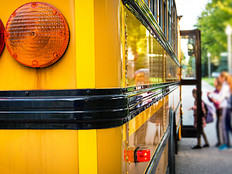Using GPS in the Classroom
In recent years, geospatial technologies, which map features on the surface of the Earth, have been incorporated into our daily lives as a means of easing navigation. Hands-on activities that incorporate geographical information systems (GIS), global
positioning systems (GPS) and remote sensing tools bring geography concepts to life for students while teaching them practical skills for functioning in the modern world.
Lesson Description: Geocaching is an outdoor game in which participants use GPS tools to hide and seek caches containing a logbook or treasure. For this activity, students will demonstrate their understanding of geography concepts and flex their creative writing muscles by creating cache-driven adventure stories that engage readers in the geography of their school's neighborhood.
Begin by having students read a few titles from the "Choose Your Own Adventure" series of children's gamebooks; then, discuss as a class the choices readers could make about the protagonist's actions to affect the story's outcome. This exercise helps students learn how to structure good adventure stories. Next, have students develop school-centric stories that include several decision points for readers. After approving the story plans, equip students with GPS devices and digital cameras and proceed outside. Have students photograph the locations that serve as their stories' decision points and use the GPS devices to record the waypoint of each location. (A waypoint is a set of coordinates that identifies a particular location for the purposes of navigation.)
Have students upload their photos and the longitude and latitude of their waypoints to a Google Map using EasyGPS (free software that transfers a GPS device's data to a PC) or MacCaching (a licensed software program for Macs). Students can then draft their stories using their story plans and the accompanying images.
When the stories are completed, have students print them and cut them into sections at each decision point. Place each section into a container with a lid and have students hide each cache at its corresponding waypoint. Post the stories and their maps on a class wiki, and load the GPS waypoints for each story onto a GPS device that students can use when they choose to explore that particular adventure.
Subject Area: Designed for elementary and middle school students, this activity focuses on geography and narrative writing.
Curriculum Standards: This lesson addresses these standards set forth by the Pennsylvania Department of Education:
- Students write multiparagraph stories for different purposes and audiences (PDE 1.4);
- Students write clear, focused text to convey a well-defined perspective and content (PDE 1.5);
- Students use geographic tools to analyze information about the interaction between people, places and the environment (PDE 7.1).
This lesson also fulfills many of the International Society for Technology in Education's National Educational Technology Standards for Students.
Resources:
- GPS Connections: gpsconnections.wikispaces.com
- Educaching (a GPS-based curriculum for teachers): educaching.com
- Dr. Alice Christie's GPS and Geocaching Guide for Educators: alicechristie.org/geocaching
Grading Rubric: Students are graded on their:
- GPS skills (locating and marking waypoints);
- GIS skills (creating and using placemarks on digital maps);
- narrative writing abilities; and
- use of digital media.
Linda Nitsche is an academic coach at French Creek Elementary in Pottstown, Pa. Erin Van Guilder is an academic coach at East Vincent Elementary School in Spring City, Pa.
Teaching Tips
- Before beginning this lesson, demonstrate how GPS devices work.
- Hide caches for students to find using the devices and have them practice marking waypoints to find the points' latitude and longitude.
- Start small, asking students to write stories with no more than three decision points.







